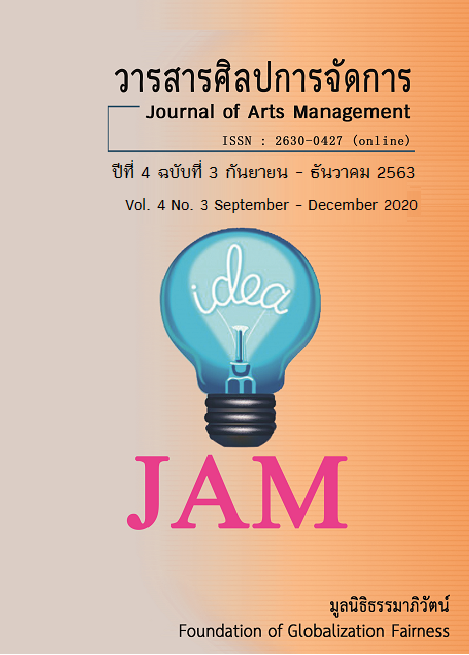Development of a Scientific Mind Test for Prathomsuksa 6 Students under Samutsongkharm Primary Educational Service Area
Main Article Content
Abstract
The purpose of this research was to develop the Scientific Mind Test for Prathomsuksa 6 students under Samutsongkharm Primary Educational Service Area. The four specific objectives were as follows: 1) to develop the Scientific Mind Test; 2) to validate the Scientific Mind Test; 3) to establish norms of the Scientific Mind Test; and 4) to construct the manual of the Scientific Mind Test. The instrument used was stratified random sampling method, research sample for scale validation and norms construction consisted of 305 Prathomsuksa 6 Students who studied in schools in Samutsongkharm Primary Educational Service Area in second semester, academic year 2020. The developed Scientific Mind Test comprised of 30 items, aimed to assess 10 Scientific mind comprised of 10 features; Curiosity, Rationality, Open-mindedness, Honesty, Determination, Prudence, Responsibility, Cooperation, Creatively and Positive Attitude toward science. The Scientific Mind Test is situation test with five different score choices.
The research results showed that the developed Scientific Mind Test could be efficiently used to assess the Scientific Mind Test of prathomsuksa 6 students under Samutsongkharm Primary Educational Service Area. The significant findings were as follows: 1) The content validity of the Scientific Mind Test, investigated by calculating the item objective congruence Index (IOC), was in the range of 0.60-1.00; 2) The item discrimination index was in the range of 0.31-0.68; 3) The construct validity of Scientific Mind Test, investigated by confirmatory factor analysis, revealed that construct validity of the Scientific Mind Test was achieved, Chi-Square (X2) with 323 df was 302.76 (p=0.78); RMR was 0.047 ; RMSEA was 0.00 ; GFI was 0.94; and AGFI was 0.91; 4) Cronbach’s alpha reliability coefficient of each featured were 0.70, 0.73, 0.72, 0.70, 0.71, 0.71, 0.70, 0.74, 0.77 and 0.81, respectively; 5) The norms for the Scientific Mind Test’s score interpretation presented in the form of the normalized T-score were in the range of T16– T82; and 6) The manual of the Scientific Mind Test was suitable and convenient for usability, explain to direction obviously and fully important composition.
Article Details
Views and opinions appearing in articles in the Journal of Arts of Management It is the responsibility of the author of the article. and does not constitute the view and responsibility of the editorial team I agree that the article is copyright of the Arts and Management Journal.
References
กระทรวงศึกษาธิการ. (2551). หลักสูตรแกนกลางการศึกษาขั้นพื้นฐาน พ.ศ. 2551. กรุงเทพมหานคร: โรงพิมพ์ชุมนุมสหกรณ์การเกษตรแห่งประเทศไทย.
จุลพงษ์ กลิ่นหอม. (2549). การสร้างแบบวัดจิตวิทยาศาสตร์ของนักเรียนระดับชั้นมัธยมศึกษาปีที่ 5 กลุ่มโรงเรียนในเครือเซนต์คาเบรียลแห่งประเทศไทย เขตกรุงเทพมหานคร และปริมณฑล. (ปริญญาการศึกษามหาบัณฑิต). มหาวิทยาลัยศรีนครินทรวิโรฒ.
ทรายทอง พวกสันเทียะ. (2553). การพัฒนาแบบวัดจิตวิทยาศาสตร์สำหรับนักเรียนประถมศึกษา. (ปริญญาครุศาสตรดุษฎีบัณฑิต). จุฬาลงกรณ์มหาวิทยาลัย.
ภัคณัฏฐ์ สมพงษ์ธรรม. (2551). การเปรียบเทียบคุณภาพของแบบวัดความสามารถในการเผชิญและฟันฝ่าอุปสรรคตามทฤษฎีของสโตลซ์ระหว่างมาตรประมาณค่ากับแบบวัดชนิดสถานการณ์: การประยุกต์ใช้ทฤษฎีการตอบสนองข้อสอบแบบพหุวิภาค. (ปริญญาครุศาสตรมหาบัณฑิต). จุฬาลงกรณ์มหาวิทยาลัย.
ล้วน สายยศ และอังคณา สายยศ. (2543). การวัดด้านจิตพิสัย. กรุงเทพมหานคร: สำนักพิมพ์สุวีริยาสาส์น.
สถาบันส่งเสริมการสอนวิทยาศาสตร์และเทคโนโลยี (สสวท.). (2555). การวัดและประเมินผลวิทยาศาสตร์. กรุงเทพมหานคร: ซีเอ็ด ยูเคชั่น.
สมควร กุลาสา, ไพศาล วรคำ และ พรรณวิไล ชมชิด. (2556). การพัฒนารูปแบบการประเมินจิตวิทยาศาสตร์สำหรับนักเรียน ชั้นมัธยมศึกษาปีที่ 1. วารสารมหาวิทยาลัยมหาสารคาม (มนุษยศาสตร์และสังคมศาสตร์), 7(3), 187-196.
สนิท ยุจันทร์. (2550). การพัฒนาเครื่องมือประเมินจิตวิทยาศาสตร์สำหรับนักเรียนช่วงชั้นที่ 3 สังกัดสำนักงานเขตพื้นที่การศึกษาสงขลา. (ปริญญาการศึกษามหาบัณฑิต). มหาวิทยาลัยทักษิณ.
สุนารี มีใหม่. (2557). การพัฒนาแบบวัดจิตวิทยาศาสตร์ของนักเรียนมัธยมศึกษาตอนปลาย: การวิเคราะห์ความไม่แปรเปลี่ยนของโมเดลการวัดระหว่างแผนการเรียน. (ปริญญาคุรุศาสตรมหาบัณฑิต). จุฬาลงกรณ์มหาวิทยาลัย.
Billeh, V. Y., & Zakhariades, G. A. (1975). The Development and Application of a Scale of Measuring Scientific Attitudes. Science Education, 59(2), 55-56.
Krathwohl, D. R. et al. (1964). Taxonomy of Educational Objectives. Handbook II Affective Domain. New York: David Mckay.


